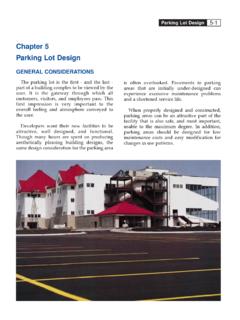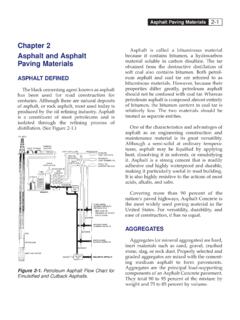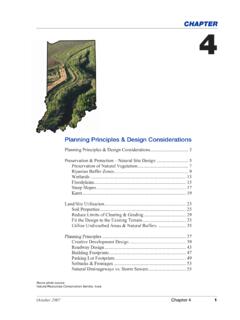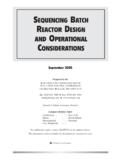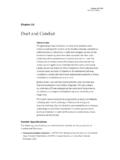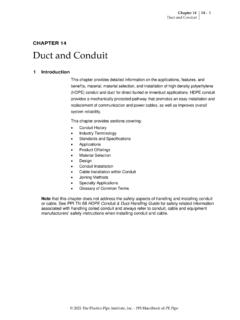Transcription of Chapter 4 Thickness Design - APAI
1 Thickness Design4-1 Chapter 4 Thickness DesignGENERAL CONSIDERATIONSS everal procedures can be used to calculatethe Thickness of the proposed asphaltpavement. All are based on the volume andweight of the traffic that will use the facilityand on the load-supporting capability of theunderlying AASHTO Road Test and other studieshave indicated that heavy-vehicle wheel loadscause much greater damage to roads than dolight loads. Thus, where large volumes oftraffic with heavily loaded trucks are antici-pated, an in-depth analysis of the pavementthickness is important.
2 Because all of thehigher functional classifications have thepotential for heavy loadings, a traffic analysisis an important part of the preparation forthickness computations. Similarly, a know-ledge of the load-bearing capability of the soilis an important aspect of the structural designprocess. The lack of a soil study with appro-priate corrective action could significantlyshorten the life of a poorly drained of the Design procedures available for astructural Thickness analysis cannot beincluded here.
3 Additional information isincluded in The Asphalt Institute s ThicknessDesign Manual(MS 1) and their Simplifiedand Abridged Versionpublished in Informa-tion Series No. 18 (IS-181). Another reference isThe AASHTO Guide for Design of PavementStructures, 1986. These guides are based onmechanistic/empirical Design models, andthey use Nomographs to attain pavementthickness. Several computer programs fordesigning pavements (including AsphaltInstitute and AASHTO programs) are alsoavailable.
4 The APAI or your contractor canhelp you with Design Design4-2 PAVEMENT Thickness DESIGNTABLESF uture traffic assignments can be rathernebulous and are subject to many externalinfluences. Some areas see no growth over adesign period. Therefore, common practice isto group categories of traffic into , it has been found that, based on alocal knowledge, soil-supporting values can begrouped into classifications of poor, moderate,and good. These classifications (see Chapter 3)provide an opportunity to use pavementthickness Design tables rather than moredetailed formula procedures.
5 These tableshave been prepared by experts in the industryto simplify the process for engineers, tech-nicians, and architects who prepare apavement ProcedureTables 4-1 through 4-5 can be used directly toselect Design thicknesses from the Design inputfactors. In order to use the tables, appropriatetraffic and subgrade classes must be selected Design procedure separates traffic intosix classes (I through VI). Each class is definedby the number of autos per day, the averagedaily number of heavy trucks expected on thefacility during the Design period, and the typeof street or highway.
6 Traffic classifications arepresented in Chapter 3. The pavementthicknesses given in the tables of this and thefollowing Chapter are based on the averagedaily traffic (ADT) values over a 20-yeardesign period. Heavy trucks are described astwo-axle, six-tire vehicles or is desirable to have laboratory tests on thesubgrade soil. However, if tests are notavailable, a Design may be based on carefulfield examinations by an engineer. Soils maybe classified as good, moderate, or poor or bya CBR value.
7 Soil classifications are presentedin Chapter 3. If a soil CBR value lies betweenthose given in the classifications, the lowerclassification is StepsThe following steps can be used to deter-mine a pavement the known average daily traffic,determine the total number of trucksover the Design period. Using thisinformation, select the trafficclassifications (Class I through VI) fromChapter a subgrade class (good, moderate,or poor) from Chapter 3 using soil datafrom the project.
8 If no soil information isknown, use the poor classification for a Design Thickness from Tables 4-1through 4-5 using the selected trafficclass and subgrade Example Acollector street is estimated to carry 500vehicles and 20 trucks a day. Traffic classIII is selected using Chapter 3. No soil data is known, so the engineerselects the poor soil classification. The total Design Thickness selected fromTable 4-2 is 7-1/2 inches. The base courseis 6 inches, and the surface course is 1-1/2 Design4-3 Residential StreetsThe primary function of residential streets isto provide access to abutting property.
9 Thisclassification consists of the largest portion ofthe street and road network and provides thelinkage to connect to higher types of speeds may be low, or higher,depending on the standards to which thespecific facility is trips on residential streets are short,and traffic volumes are low. Truck traffic isusually limited to vehicles that provideresidential services such as trash pickup,moving vans, heating oil delivery, Design : Residential StreetsA. For Asphalt Concrete Base PavementsThickness in InchesDesign Criteria*Asphalt ConcreteTraffic ClassSubgrade(ADT) (50-200 ADT) (201-700 ADT) For Untreated Aggregate Base PavementsDesign Criteria* Thickness in InchesUntreatedAsphaltAsphaltTraffic ClassSubgradeAggregateConcreteConcrete(A DT) (50-200 ADT) (201-700 ADT)
10 *See Chapter 3 for traffic and soil class detailsThickness Design4-4 Collector StreetsCollector or feeder streets connect theresidential street system with arterial classification of street serves dualfunctions of both land access and through-traffic movement. The mileage of collectors inany one jurisdiction may be very , collectors have moderate amountsof low-to-intermediate-speed traffic, includingsome bus traffic, and heavy Design : Collector StreetsA. For Asphalt Concrete Base PavementsThickness in InchesDesign Criteria*Asphalt ConcreteTraffic ClassSubgrade(ADT) (50-200 ADT) (201-700 ADT) (1,501-4,500 ADT) For Untreated Aggregate Base PavementsDesign Criteria* Thickness in InchesUntreatedAsphaltAsphaltTraffic ClassSubgradeAggregateConcreteConcrete(A DT) (50-200 ADT) (201-700 ADT) (1,500-4,500 ADT)
